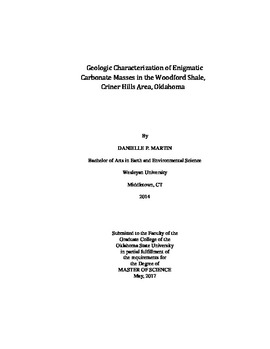| dc.contributor.advisor | Pashin, Jack C. | |
| dc.contributor.author | Martin, Danielle P. | |
| dc.date.accessioned | 2018-06-13T16:19:37Z | |
| dc.date.available | 2018-06-13T16:19:37Z | |
| dc.date.issued | 2017-05-01 | |
| dc.identifier.uri | https://hdl.handle.net/11244/300032 | |
| dc.description.abstract | The origin of carbonate masses in the Devonian Woodford Shale in the McAlister Cemetery Quarry in south-central Oklahoma have long been an enigma. Masses range from 24 cm to 1.5 m in diameter and are sub-spherical to oblate or ellipsoidal in shape. Field, petrographic and geochemical results reveal a much more complex diagenetic history than previous research suggests. The masses formed below the sediment-water interface with varying paleoredox conditions and were altered through the complete geologic history of the Woodford Shale in the Criner Hills Uplift. The carbonate masses consist of a nucleus and surrounding outer rings. They are composed of microcrystalline calcite with microfossil pseudomorphs and intercrystalline bitumen, and a sparry rind perimeter composed of calcitic and hematitic bands. Field and petrographic evidence, and geochemical results indicate that the concretions began accreting in normal marine waters during early diagenesis preserving the precompactional sediment fabric. Masses show consistent isotopic trends from the nucleus to outer rings: Positive trends in ?13C (-20.09 to -7.40‰ VPDB) and negative trends in ?18O (-0.86 to -5.99‰ VPDB) and ?15N (+0.51 to +10.59‰ relative to air). Isotopic trends continue in the sparry rind: Positive trends in ?13C (-3.95 to +13.59‰), ?18O (-5.47 to -3.06 ‰) and ?15N (-6.92 to +16.78‰). High ?13C values indicate that the calcitic and hematitic rind precipitated in isotopically heavy pore waters, facilitated by microbially mediated methanogenesis. Trace element concentrations (V, Ni, Mo) increase in the sparry rind, indicating increase in metal availability during rind growth. Geochemical evidence combined with field and petrographic evidence suggests that the carbonate masses underwent a broad range of events, including dissolution and mechanical reworking, possibly associated with Late Pennsylvanian and sub-Cretaceous unconformity development in the Criner Hills. | |
| dc.format | application/pdf | |
| dc.language | en_US | |
| dc.rights | Copyright is held by the author who has granted the Oklahoma State University Library the non-exclusive right to share this material in its institutional repository. Contact Digital Library Services at lib-dls@okstate.edu or 405-744-9161 for the permission policy on the use, reproduction or distribution of this material. | |
| dc.title | Geologic Characterization of Enigmatic Carbonate Masses in the Woodford Shale, Criner Hills Area, Oklahoma | |
| dc.contributor.committeeMember | Riedinger, Natascha | |
| dc.contributor.committeeMember | Gregg, Jay M. | |
| osu.filename | Martin_okstate_0664M_15138.pdf | |
| osu.accesstype | Open Access | |
| dc.description.department | Geology | |
| dc.type.genre | Thesis | |
| dc.type.material | text | |
